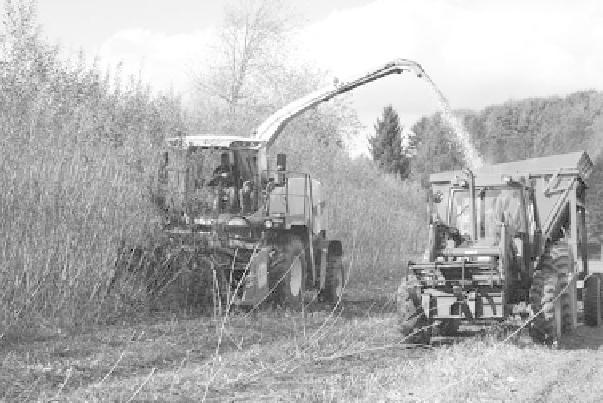Environmental Engineering Reference
In-Depth Information
FIGure 28.5
Harvesting shrub willow using a self-propelled forage harvester with a specialized willow
cutter head. The forage harvester blows wood chips into a dump wagon being towed alongside.
covered or outside. The moisture content of willow biomass harvested during the winter months is
approximately 45-50%, which adds water to any industrial conversion process if used immediately.
This may be advantageous for the pretreatment and saccharification steps needed for the biological
production of biofuels, but it lowers the net energy content of the biomass for combustion applications.
A small amount of microbial respiration occurs in the center of the pile until oxygen is depleted, but
the heat generated is sufficient to dry the biomass down to 30-35% moisture content. To prevent the
wood chips from further degradation and contamination with microbes, they may be dried using
a forced-air dryer, which adds expense, but improves the combustion efficiency and storage life
(Gigler et al. 1999).
Willow biomass may be burned directly in a wood-fired boiler or may be co-fired with coal to
generate heat and/or power with a net energy ratio of approximately 1:11 (Mann and Spath 1999;
Tharakan et al. 2005). In this application, drying to a moisture content of 30-35% is adequate, but
the chips may need to be milled to a smaller dimension with a hammer mill. When bulk loads of
biomass need to be transported long distances and stored before use, processing to increase the bulk
density is justified, including manufacture of wood pellets and briquettes which requires drying the
biomass to 11% moisture content. Wood pellets are increasingly being used for home heating in
North America; however, much of the equipment is designed to use premium-grade pellets with less
than 1% ash content to minimize maintenance concerns (Biomass Energy Resource Center 2007).
The ash content of shrub willow wood is 0.5-1.1% and of bark is 4.8-5.9% (Senelwa and Sims
1999; Klasnja et al. 2002), with bark content of mature stems ranging from 14-19% (Adler et al.
2005; Serapiglia et al. 2009). Thus, willow biomass can be mixed with wood residues or debarked
tree chips to make premium-grade wood pellets, or they can be used exclusively in the production
of standard-grade (1-2% ash) or industrial-grade (>3% ash) wood pellets. There are also several
high-efficiency wood chip boilers on the market that can use dried willow chips directly, including
models produced by KWB of Austria (www.kwb.at/en/).
Willow biomass has been used as a feedstock for the production of ethanol as a liquid transportation
fuel in laboratory research, and commercial deployment of this technology is imminent with near-
term advances in pretreatment and saccharification technology (Eklund et al. 1995; Eklund and
Zacchi 1995; Hahn-Hagerdal et al. 2006). Because willow is a viable, high-yielding feedstock crop
for many locales, it is vital that the bioethanol conversion technologies that emerge will be compatible
with willow biomass feedstock characteristics. Recent research has shown that steam pretreatment

